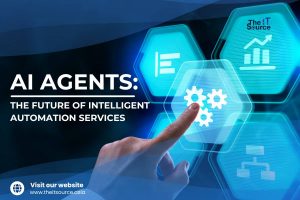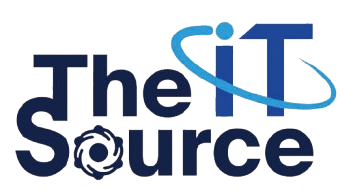AI Agents: The future of intelligent automation services

The modern business landscape operates at an unprecedented velocity. Escalating customer expectations for instant, personalized experiences, coupled with immense internal pressure to optimize performance, have created a complex challenge for technology leaders. Traditional Robotic Process Automation (RPA), long a cornerstone of efficiency, is now revealing its inherent limitations. While effective for structured, rule-based tasks, it falters when faced with the dynamic and complex workflows that define today’s business operations.
To break through these barriers, a new generation of technology is emerging as a transformative force: the AI intelligent agent. This represents not just a tool, but a paradigm shift moving from automating clicks to automating entire decision-making chains. As a strategic partner in digital transformation, The IT Source – a global partner for software development and AI services, has seen firsthand how this technology reshapes businesses. This article provides a deep dive into the strategic value of AI Agents, their core differentiating capabilities, the most effective areas for application, and the optimal roadmap for successful implementation.
The strategic imperative of intelligent automation
In the digital-first economy, delaying the adoption of breakthrough technology is equivalent to ceding competitive ground. Investing in an AI intelligent agent is no longer a “nice-to-have” option but a critical necessity, driven by several strategic imperatives:
The demands of the experience economy: Customers today don’t just buy products; they buy seamless experiences. They expect 24/7, instantaneous support and personalized solutions. Meeting this demand at scale with a purely human workforce is both financially unsustainable and operationally complex. An AI agent is the key to delivering this superior service level consistently and cost-effectively.
The limits of linear scaling: Every manual process has a finite performance ceiling. Simply adding more personnel to handle increased workloads leads to exponential cost growth and managerial complexity. Intelligent automation allows an organization to shatter this ceiling, processing a near-limitless volume of tasks at a low marginal cost.
The talent scarcity risk: The war for high-skilled tech talent is fierce and unrelenting. Over-reliance on manual processes not only inflates costs but also exposes the business to significant operational risk when talent cannot be sourced. An AI agent automates high-volume, low-complexity work, liberating valuable human experts to focus on strategic, innovative, and high-value initiatives.
Deconstructing the AI intelligent agent: What is it apart?

To grasp its strategic importance, one must understand the core capabilities that define the AI intelligent agent. If an RPA bot is a diligent soldier following explicit orders, an AI intelligent agent is a field commander on the digital battlefield, possessing four key competencies:
- Contextual perception: Moving far beyond structured data entry, it leverages large language models (LLMs) to comprehend the intent behind a customer’s email, extract critical clauses from a complex PDF contract, or identify data fields on an unfamiliar application interface.
- Reasoning and decision-making: This is the primary differentiator. When faced with an exception not covered by a pre-defined script, an AI agent doesn’t simply stop and report an error. It analyzes related data, references past similar cases, and makes an informed, logical decision to advance the process.
- Autonomous action: It can independently execute complex, multi-system action sequences. For instance, based on a single email request, it can generate a sales order in an ERP, update customer records in a CRM, and dispatch a notification to the logistics team via Slack.
- Learning and optimization: Every completed task serves as a learning opportunity. The agent continuously refines its processes over time, becoming faster, more accurate, and more efficient without requiring manual reprogramming.
A practical roadmap for AI agent implementation
A successful technology deployment requires a clear and pragmatic roadmap.
Identifying high-impact use cases:
Not all processes are ideal candidates for initial AI automation. The key is to target “beachhead” applications that deliver visible, high-impact results quickly:
- Customer-facing processes: Level-1 technical support, quote generation, appointment scheduling, and order tracking are perfect starting points. Automating these areas not only cuts costs but also directly improves customer satisfaction (CSAT) scores.
- Back-office operations: Repetitive, high-volume processes within finance (invoice processing), HR (new hire onboarding), and IT (service desk ticket management) are ripe for transformation.
- Data aggregation and synthesis: Automating the collection of data from partner reports, synthesizing it, and generating daily or weekly business intelligence dashboards can save hundreds of man-hours.
Recognizing key business triggers for adoption:
The optimal time to invest in an AI intelligent agent is often signaled by specific strategic inflection points that technology leaders must recognize:
- When linear headcount scaling becomes unsustainable: This occurs when the cost of adding new employees to handle operational growth begins to erode profit margins, indicating that manual processes have reached their economic limit.
- When operational risk and compliance gaps emerge: An increase in human-induced errors in critical processes, such as financial reconciliation or data entry, signals that manual oversight is failing. This creates significant compliance and financial risks that intelligent automation can mitigate through consistent, auditable execution.
- When talent attrition threatens innovation: If your most skilled employees are spending a significant portion of their time on mundane, repetitive tasks, it leads to burnout and high turnover. This “talent drain” directly impacts the company’s ability to innovate and should be a powerful trigger for automating lower-value work.
- When time-to-market becomes a competitive disadvantage: If manual bottlenecks in processes like customer onboarding or order fulfillment are causing delays that allow more agile competitors to win business, it’s a clear sign that automation is needed to restore competitive parity and speed.
Smart sourcing: The strategic approach
Building in-house AI capabilities from scratch is expensive and high-risk. That’s why a smart sourcing approach partnering with a specialized software outsourcing provider has become the most effective path. The outsourcing industry is shifting from labor arbitrage to providing end-to-end technology solutions.
Partnering with a firm like The IT Source provides dual advantages:
- Instant expertise: Immediate access to solution architects, data scientists, and AI developers.
- Accelerated time-to-value: An outsourcing partner can rapidly deliver MVPs, validate concepts, and reduce investment risk. As Deloitte highlights, leveraging external partner ecosystems is now a key driver of agility and innovation.
The intelligent automation revolution
The intelligent automation revolution is not on the horizon; it is here. AI adoption has surged dramatically, with a recent McKinsey report showing that 72% of enterprises now use AI in at least one business function, a significant jump from the 50% adoption rate seen in previous years.
Will your organization lead the charge in redefining your industry, or be left struggling to keep pace?
Schedule a complimentary strategy workshop with The IT Source today to explore the potential of AI agents and build a custom automation roadmap designed for your enterprise.


 日本語
日本語
